2023 Brand Trend Report
Welcome to our latest trend report, where we take a look at the most exciting and cutting-edge branding trends that are shaping the industry. In this report, we will explore a variety of trends across different areas of brand design, including color, user experience, and utilization of new technology. The treads we will touch on have been categorized as “key trends” and “other notable trends.” We will examine how these trends are being used by top brands and designers. This report will give you a comprehensive and thought provoking walk through of key and notable projected trends of 2023.
For additional details and visual examples of the trends mentioned, please see the full version of the trend report which can be found here.
Key Trend 1: A Revolution in Design Tools
Arguably the biggest change in graphic design in 2023 will be how we make them. Artificial Intelligence (AI) has been integrated into various sectors over the past ten years. AI generators that can generate captivating images and artworks by utilizing algorithms and data sets have emerged. They have accelerated workflows and created countless possibilities for the field. Nick Hill of Re Design states, “if late 2022 was defined by the emergence of AI in art and design, I think we’re really on the edge of a design tool nirvana. Plugins and tools have always been around but stuck behind tricky workflows,” he explains. “Tools like Figma helped democratise the ‘plugin’, and at Re Design, we now use the software for so much more than what it was clearly originally intended for. Apps like Runway have made inpainting and masking content, which used to take hours of specialised work, available in minutes.” The tension is whether we can use this growing space almost ‘invisibly’ or that the tools become too evident and repetitive in work,” he adds.
It is also important to note the other side of this trend. There is also a gray area that creatives are entering when it comes to AI generated art and topics much like this. Getty Images recently banned AI-generated content over fears of legal challenges. Other companies such as Newgrounds and PurplePort have followed suit. Getty Images CEO Craig Peters states, “we are being proactive to the benefit of our customers.” The creators of AI image generators say the technology is legal, but that’s no guarantee this status won’t be contested. Getty Images competitor Shutterstock, seems to be limiting some searches for AI content. They are yet to introduce specific policies banning the material however.
Overall, programs such as DALL-E and Midjourney are making creating art with AI accessible to all and we are certain that these new tools will impact the way we consider design and observe our environment.
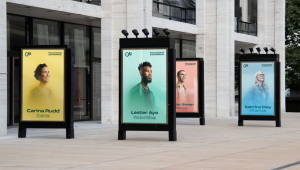
Key Trend 2: Designing for Hyper-reality
Designers are now required to have expertise in both physical and digital realms, and the future involves utilizing technology such as AI, AR, VR, MR and real-life to create fully engaging brand experiences. While these fields are not novel, they are rapidly advancing, and they extend far beyond traditional graphic design, making it an exhilarating time to be a creative. Holly Karlsson, creative director at Bulletproof states, “3D OOH billboards offer hyper-realistic and immersive brand experiences, blurring the lines between technology and reality. Then there are Al data sculptures, such as the mesmerizing work of Refik Anadol and the emergence of Al image generation based on machine learning, such as DALL-E 2. We should embrace these evolving mediums and use them to our advantage whilst drawing on our more traditional design skills.”
2023 promises to be an exciting and ground-breaking year for AI-generated content, with plenty of innovative ways for creatives to use this technology to their advantage. However, it is important for designers to stay on the ball and be aware of automated tools like DALL-E and decide whether they want it to be part of their professional repertoire. Web 3.0 is offering artists and designers unprecedented control over their digital output – so, who knows, we might even see a rise in ‘house styles’ and a shift towards design as ‘art’. By combining traditional design skills with a deep understanding of these emerging mediums, we can create truly innovative and impactful brand experiences that capture the imagination of consumers.

Key Trend 3: Human Connection and Substantive Promises
This trend focuses on looking for inspiration in everyday moments. These moments can communicate your brand in a very intimate way by using design elements that act as an understated facilitator for authentic human storytelling. It’s not just about the product or solution you offer, but about the values and emotions that your brand represents. Fostering an atmosphere of trust and transparency should be top of mind. Shantanu Kumar stated on UX planet that, “according to Edelman’s annual trust studies, trust in institutions and brands has been declining year after year, and this trend is likely to continue in 2023. As trust in brands continues to decline, it is becoming increasingly important for companies to focus on building credibility and trustworthiness to connect with consumers.” Over the years we have seen consumers demanding companies to take a stance on social and political topics and we’re seeing that statements alone aren’t enough.
One way that brands have responded to this demand is by having more inclusive visuals. By doing this it is helping audiences from all walks of life see themselves reflected in a business’s products and mission. There are many examples of when a brands values and mission doesn’t line up with their actions, for example, H&M, a multinational clothing company based in Sweden that focuses on fast-fashion clothing for men, women, teenagers, and children, was accused of green washing and engaging in false advertising about the sustainability of their clothing. There are, however, many companies that serve as great examples when it comes to being a brand that is open and honest about their products, services, and values. One important brand to note here is Patagonia, an American retailer of outdoor clothing. This brand is known for its commitment to transparency and sustainability in their business practices. They use videos on their website to showcase the process of sourcing and manufacturing their products and invite customer feedback to improve their operations.

Key Trend 4: Mixed Dimension
In 2023 graphic designers are shattering the boundary between online spaces and physical ones. Though this trend can seem dystopian, it is actually much more focused on joy and whimsy. This trend explores the contrast between these two different spaces with vibrant splashes of color, brush like strokes to highlight key graphical elements, and engaging characters to aid in telling the unique stories of the brand. Rather than taking away from the real-life imagery, the blending of these styles actually emphasizes the power and impact that imagination and art can have in the world. Brands can use this trend in many ways like adding simple illustrative line work to highlight product’s key features, creating limited edition packaging with seasonal elements or giving brand photography and social assets a glow up with bold, vibrant swashes of color. 99 Designs team states, “it also shows the world as we might like it to be, a place of discovery and wonder. When life sometimes feels gloomy, it is the imaginative power of art that offers escape and reminds us that we are capable of creating magic, if we just put our minds to it.”
One notable trend that falls under this same category of Mixed Dimension is Surrealist Maximalism. As minimalism, as a trend, has been on the rise for a few years now, we are starting to see how it is evolving in new and creative ways. It is true that the pandemic has had a significant impact on various aspects of life, including art and design. The surrealism and maximalism aesthetic styles have been gaining popularity as a way for designers to push boundaries and make bold statements. As people emerge from the confinement of the pandemic, there is a desire for more expressive and dynamic designs that break away from traditional norms. These styles are often characterized by bold colors, exaggerated forms, and a mix of different elements, which can create a sense of wonder and surprise for the viewer.
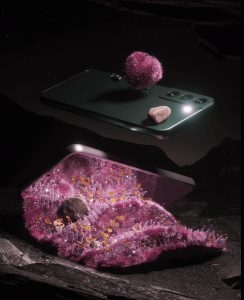
Other Notable Trend 1: Retrofuturism
With all of the exciting new technological possibilities, retrofuturism is a trend which is influenced by this. Andenew Ayele, associate creative director at ThoughtMatter says, “design trends are leaning into what can roughly be described as retrofuturism. The strong surge of newly available tech and digital resources have made Web3, AI-generated and 3D art accessible. These advances have also lent to nostalgia-driven typefaces, dynamic retro color swatches, and the ability to honor previous modes of graphic production with seeming authenticity and ease.” Last year, anti-design was on the rise. This is a good indicator of retrofuturism and what is to come in the future. Andenew also states that, “designers and non-designers alike have often questioned the relationship between people and brands because of their inability to be relatable, to create compelling ideas and individuality, to foster storytelling, to keep humanity at the forefront through their work and products. Now is not the time for brands to swim in the sea of sameness with a safe, bland brand identity and visuals that appeal to everyone. If this surge of tech and resources continue to blossom, the near future will be marked by a non-linear approach to time, inspiration, process and creativity as a whole. Without the constraints of rigid guidelines and limited resources, we foresee individuality and emotive work to be on the rise.”
Retrofuturism is a unique style that seamlessly blends modern-day aesthetics with futuristic technology and traditional design elements. At its core, it features a combination of grungy, faded aesthetics with futuristic themes, creating a nostalgic yet forward-looking feel. The design incorporates elements of retro design, with a focus on vibrant colors and technology and machinery. The shapes used in retrofuturism are usually smooth and rounded geometric shapes, which adds to the overall aesthetic of nostalgia and futurism.
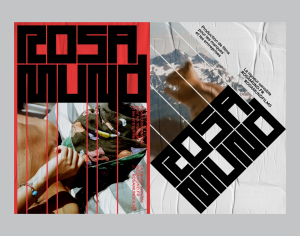
Other Notable Trend 2: Folk Botanical
Patterns in graphic design are often inspired by nature, and the use of natural elements such as leaves, fruits, and vines can create dynamic and lively compositions. This trend is a departure from more traditional and refined nature patterns, and instead incorporates elements such as shaky doodles, rough textures, and unexpected color combinations to create a more whimsical and organic feel. This trend emphasizes the human touch and imperfections in digital artwork, which can add a sense of warmth and personality to the design and awaken a feeling of familiarity in the customer. The use of this trend in nature patterns can create a unique and unexpected visual experience for the viewer.
This approach works well in making digital work feel more natural and perfectly imperfect. It uses bright, whimsical, nature inspired patterns that are intentionally imperfect, even childlike, providing a casual, comforting alternative to more “polished” designs. Alice Z., Designer at 99designs by Vista, describes this style by saying, “the paint-textures give designs a lively look, and I hope we’ll be able to see more usage of hand-made textures. Some customers still prefer “too smooth” and “polished” designs, but imperfections are really cool.
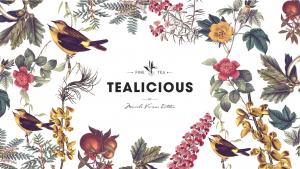
Other Notable Trend 3: Foil Printing
Foil printing is projected to be popular trend in graphic design for 2023, which adds a unique luxurious and stylish touch to print materials. It can be used in various ways, such as full gold for sophistication or multi-colored foil for a futuristic look. Brands can use foil printing to add a touch of class and sophistication to their products. Custom foil business cards are an example of the possibilities of using foil in graphic design.
Team Jukebox says, “there are practically limitless possibilities for how to use foil. For instance, you can go full gold to give a product an air of sophistication or you could use multi-colored foil to make it appear more futuristic.”
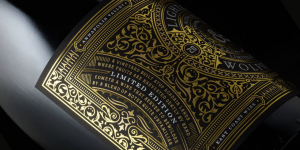
Other Notable Trend 4: Motion Graphics
Today, advancements in design technology have made it possible to create high-quality, moving images that can be used for both indoor and outdoor advertising. Now you can see small billboards at bus stops, outside of a mall, or randomly placed in a city square. Brands don’t need a million-dollar budget anymore to show their brand in motion. And, in doing so, are creating new layers of depth for consumers.
Motion in advertising can be more engaging and attention-grabbing than static imagery, and can create a deeper connection with consumers by telling a story or creating a sense of identity. Advancements in design technology have made it more accessible and cost-effective for brands to use moving images in their advertising. When Mitch Paone, partner and creative director at DIA Studio got the question: ‘Why is motion so important anyway?’ He responded, “On a superficial level, a static image can’t compete with a looping GIF. On a deeper level, movement creates identity, just like how we can identify a salsa dancer versus a hip-hop dancer. The dancer could be the same, but their motion tells the story.”
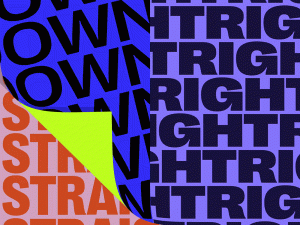
Related Articles
Feb 09th, 2023
2023 Brand Trend Report
Feb 01st, 2023
Cloud Migration
Aug 24th, 2023